How to Bridge to BNB Chain Using deBridge: Fast, Secure, and Simple
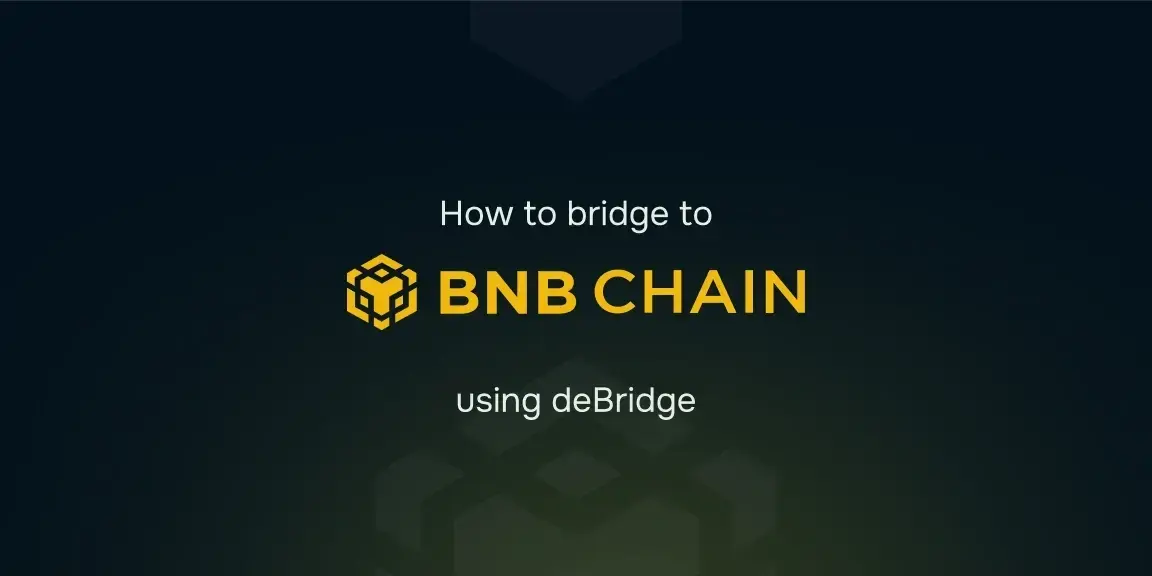
Table of Contents
- Why Users Bridge to BNB Chain
- Before You Start: What You Need to Bridge
- Official BNB Chain Bridge
- Step-by-Step: How to Bridge to BNB Chain Using deBridge
- Comparison Table: deBridge vs Other Options (Binance, Celer, Stargate)
- Developer Integration & Widget Use Cases
- Security Advantages: Why deBridge is Safer
- Conclusion
- Frequently Asked Questions (FAQs)
Originally launched as Binance Smart Chain (BSC), BNB Chain has grown into a leading Layer 1 blockchain, offering high performance, low transaction fees, and seamless compatibility with the Ethereum Virtual Machine (EVM). It powers a thriving ecosystem of DeFi protocols, NFT marketplaces, and dApps (decentralized applications). Backed by the BNB token, the network can process thousands of transactions per second with near-instant finality, making it a natural choice for traders, builders, and yield seekers.
Yet, getting assets onto Binance Smart Chain isn’t without challenges. Traditional bridges often rely on wrapped assets that introduce smart contract and liquidity risks. High gas fees on source chains can make small transfers inefficient, while slow transaction times create uncertainty for traders and developers needing fast settlement.
That’s where deBridge comes in. A 0-TVL architecture to help you move assets at lightning speed from Ethereum or other chains to BNB Chain, with native asset delivery and execution. This means you can start exploring BNB Chain’s ecosystem with confidence, whether you’re deploying a dApp, diving into the trenches, or exploring the DeFi space.
Why Users Bridge to BNB Chain
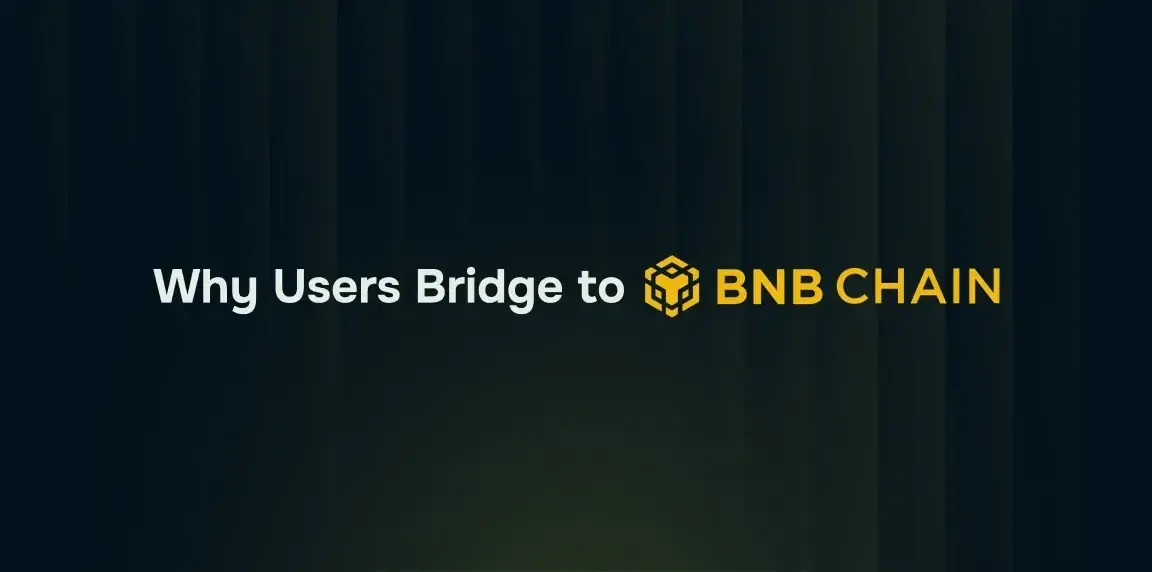
BNB Chain has become a go-to destination for both everyday and power users thanks to its low transaction fees, fast confirmations, and full EVM compatibility. This means any Ethereum-native dApp, wallet, or tool can work seamlessly to onboard users from the chainscape. Its ecosystem spans high-yield DeFi protocols, NFT marketplaces, and GameFi projects, all supported by a wide range of assets available on deBridge.
Common Use Cases
- Accessing yield farms and lending protocols
- Trading on low-fee decentralized exchanges (DEXs)
- Minting or trading NFTs on popular marketplaces
- Moving stablecoins for faster settlement
- Deploying Ethereum-compatible smart contracts
Bridging to BNB Chain lets you tap into a fast-growing network built for scalability and interoperability.
Before You Start: What You Need to Bridge
Before moving your assets to Binance Smart Chain, make sure you’re set up for a smooth, secure bridging experience. First, you’ll need an EVM-compatible wallet such as MetaMask, Coinbase Wallet, or Trust Wallet. The wallet allows you to interact with Ethereum, BNB Chain, and many more. It is also important to have a small amount of ETH (for Ethereum gas fees) and BNB (for BNB Chain gas fees) ready, as you’ll need both depending on the direction of your transfer.
If your wallet isn’t connected to BNB Chain yet, you can quickly configure it using tools like Chainlist by connecting your wallet or manually filling in the RPC details. Finally, use a trusted bridge to protect against liquidity risks and smart contract risks. Double-check URLs, confirm transaction details, and avoid interacting with unknown contracts. With the right wallet, gas setup, and security mindset, you’re ready to bridge confidently.
Official BNB Chain Bridge
BNB Chain Bridge is the native bridge of BNB, allowing token transfers between different chains and the BNB Smart Chain. The official bridge acts as an aggregator, gathering quotes from several bridges (such as deBridge) to assist you in transferring assets to the destination chain, namely BNB Chain.
What are the limitations of the official BNB Chain Bridge?
The BNB Chain Bridge is designed to support a restricted selection of assets, potentially excluding users with tokens that are not part of this list. Additionally, you might not be aware of the best bridge route, as some options may take longer, so it may not be ideal for users seeking to bridge assets quickly.
The cross-chain bridge could be even better with advanced features like native token swaps and cross-chain dApp integrations, enhancing its appeal to the DeFi-native audience! Let's explore the easy, fast, and secure option for bridging tokens so you can explore decentralized applications on the BNB Chain.
Step-by-Step: How to Bridge to BNB Chain Using deBridge

BNB Chain currently lacks a native solution for transferring funds from a blockchain to BNB Chain. That's where deBridge comes in. It offers a quick and secure way to bridge assets between BNB Chain and 25 other networks. Let's walk through the steps to perform bridging for your crypto assets:
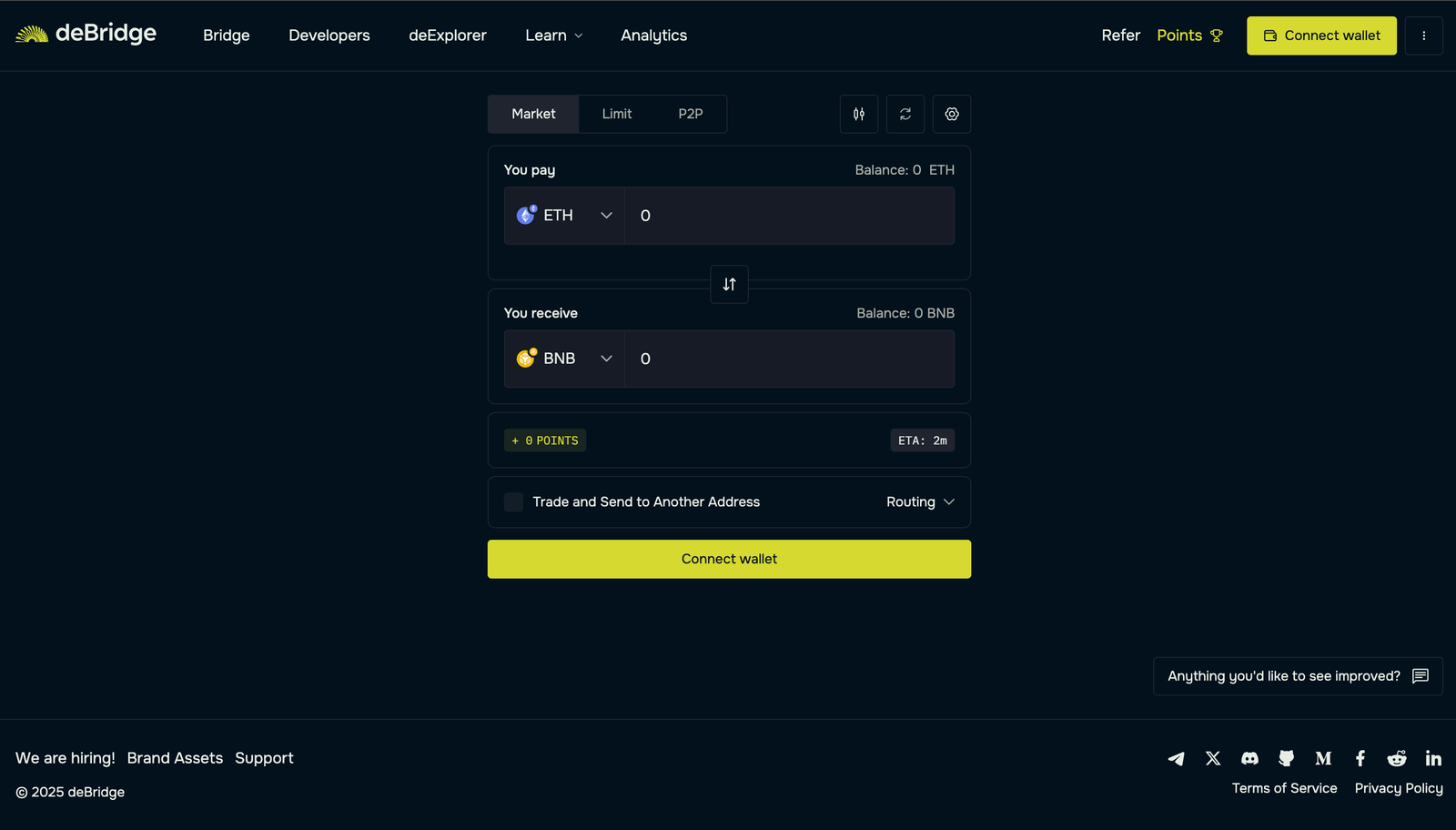
- Select the source chain and asset you’d like to bridge. Here, we will select Ethereum as the source chain and ETH as the asset.
- Next, select the destination chain and asset you’d like to receive. Here, we will select BNB Chain and BNB as the asset on the target chain.
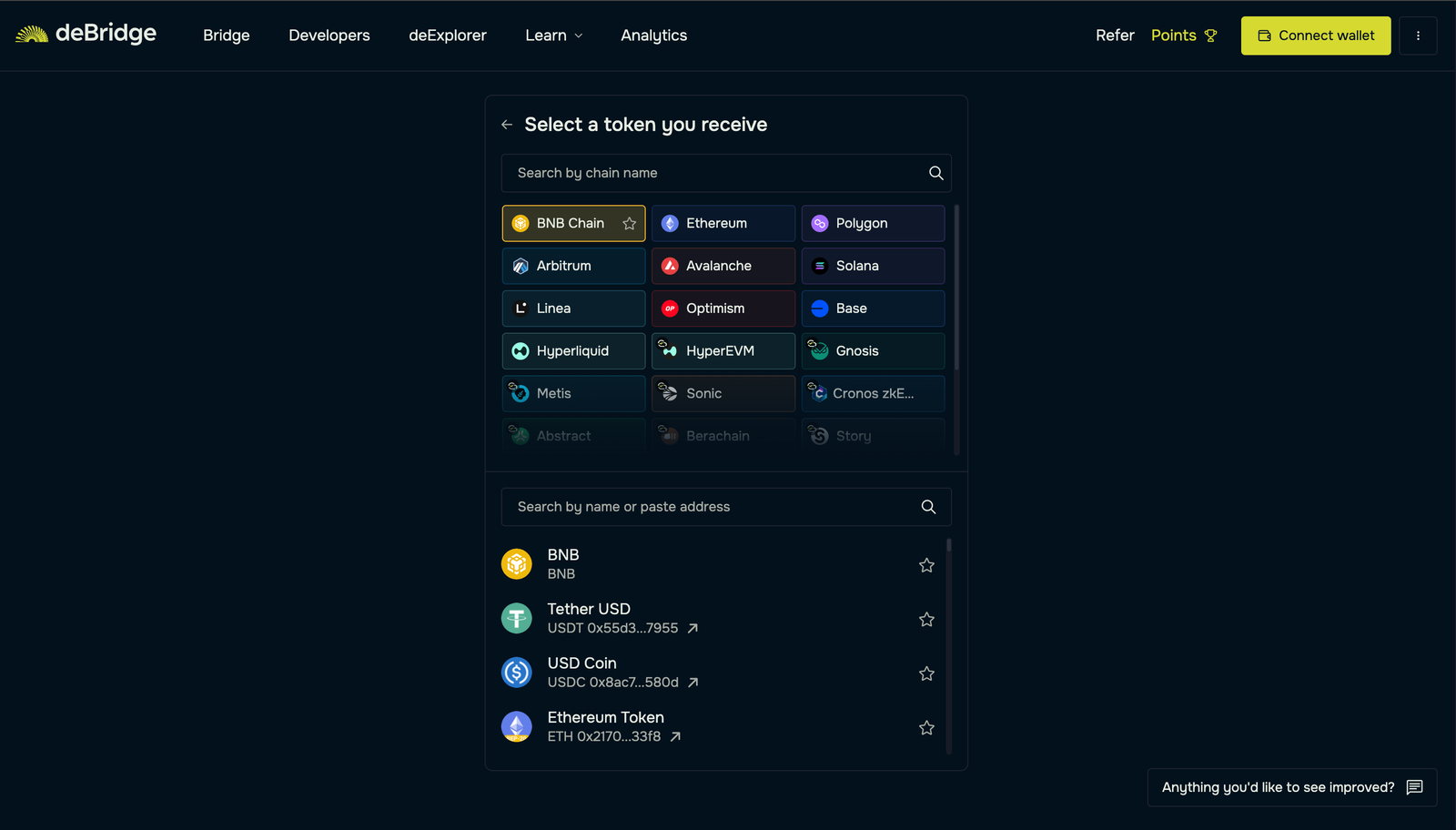
- Connect your EVM wallet as the source and destination.
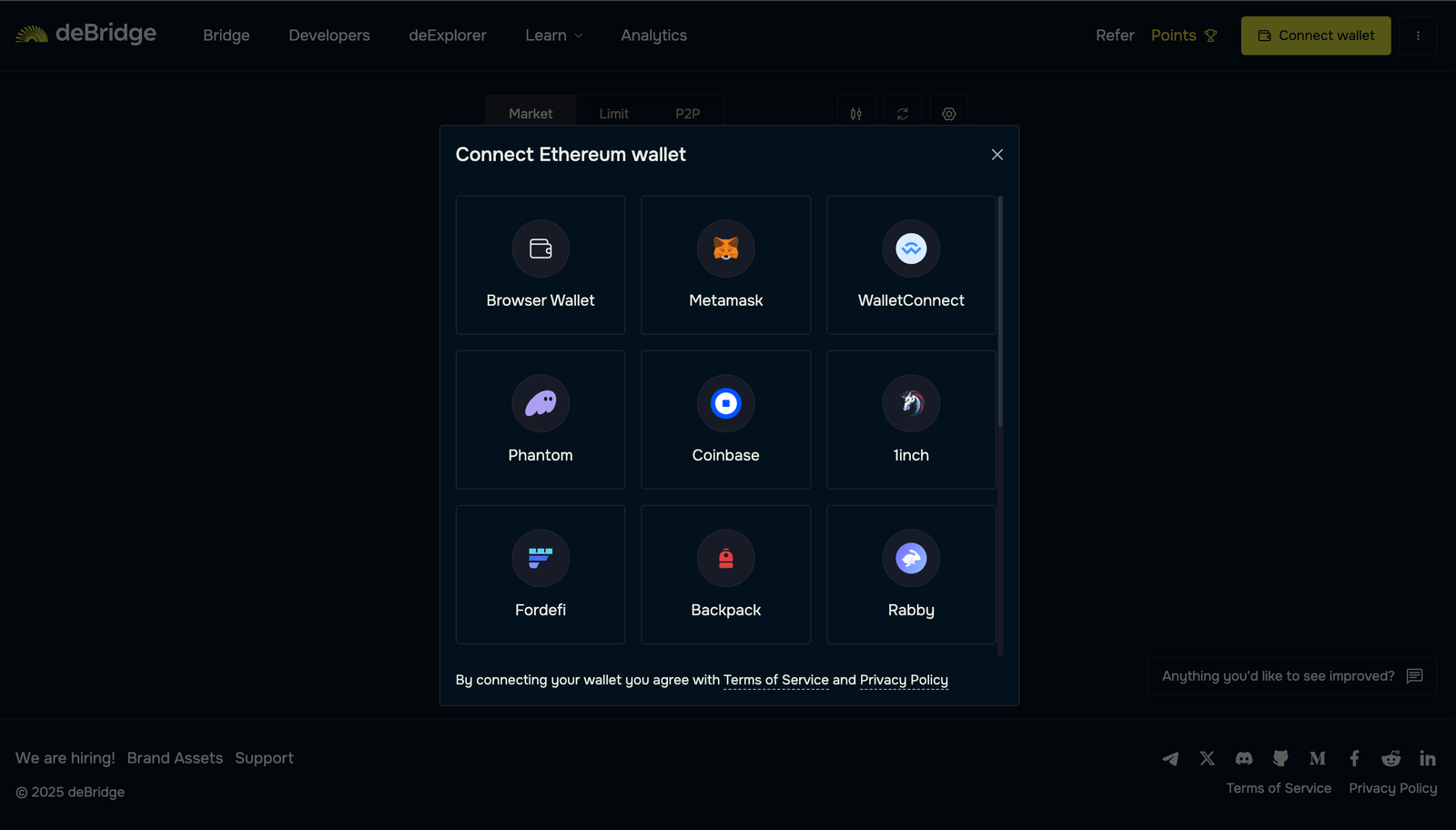
- Enter the ETH quantity and review the transaction details.
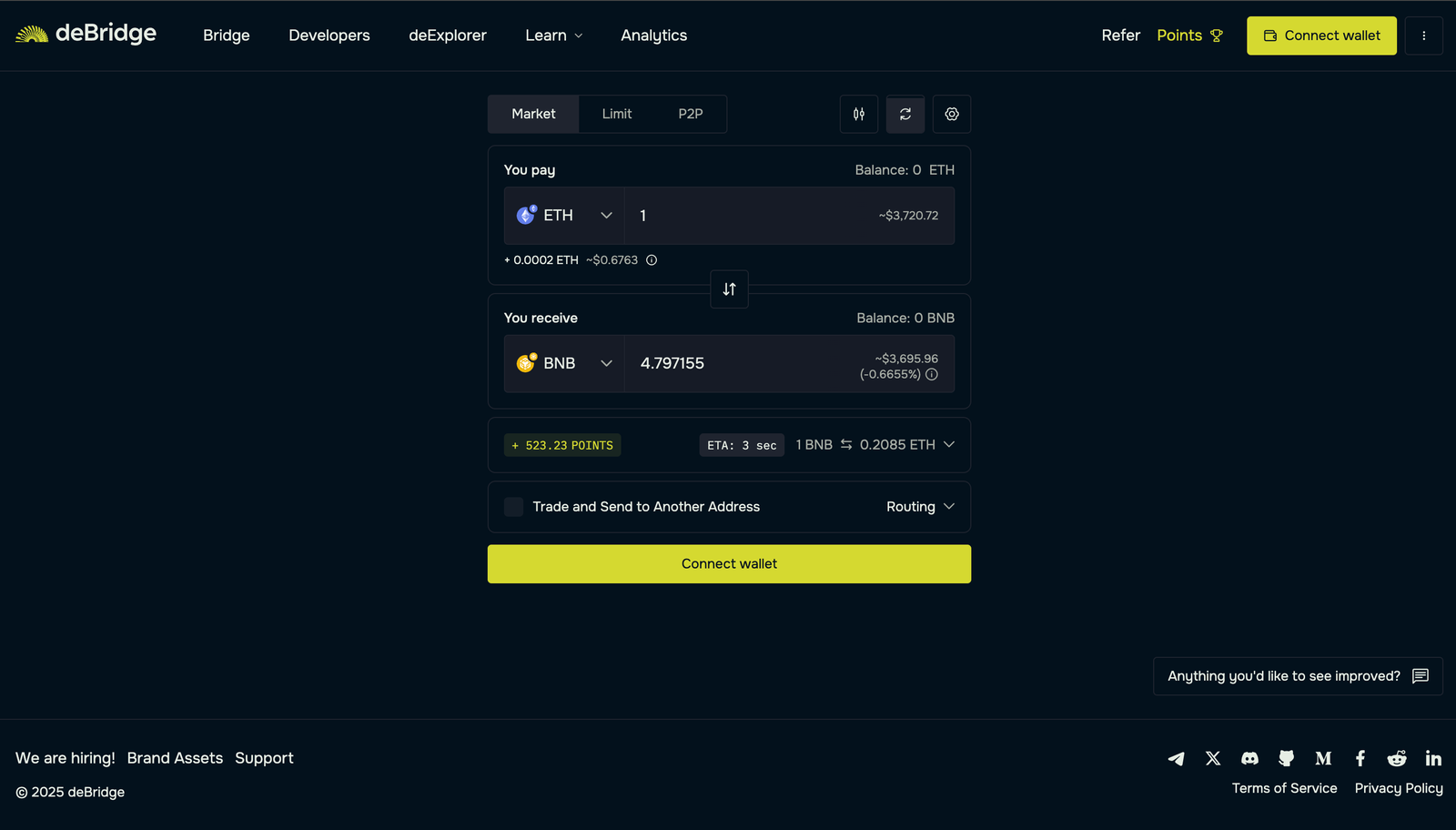
- Confirm trade and sign the ensuing transactions to receive native BNB in your BNB Chain account.
Pro Tips
- Make sure you have sufficient BNB in your destination chain (Binance Smart Chain) for future transactions.
- Try to avoid bridging during peak hours to save on ETH gas costs. You can track gas prices on Etherscan.
With the BNB Smart Chain, you can enjoy a seamless experience with low network fees, ensuring your BNB tokens arrive in your wallet in just a few seconds. Technical users can also inspect the transaction(s) on the BNB Chain explorer.
Comparison Table: deBridge vs Other Options (Binance, Celer, Stargate)
When choosing a bridge to move assets to BNB Chain, the differences in speed, security, and asset handling can make or break your experience. Many popular options rely on wrapped tokens or liquidity pools, adding risk and delays. deBridge stands out by delivering native assets with deep liquidity, near-instant finality, and a trust-minimized design.
Developer Integration & Widget Use Cases
For builders, deBridge offers a seamless way to integrate cross-chain transfers directly into their dApp, exchange, or wallet. With our API and embeddable bridge widget, you can enable users to move assets across supported networks, including Ethereum, Binance Smart Chain, Arbitrum, Solana, and more, in seconds.
Teams can customize the widget to match their brand colors and embed it anywhere for quick onboarding. This makes it ideal for DeFi protocols, dApps, telegram bots, wallets, and more to deliver a smooth, native bridging experience without redirecting users from your app.
Start building with deBridge today. Explore our documentation and guides to see how easy it is to go live.
Security Advantages: Why deBridge is Safer
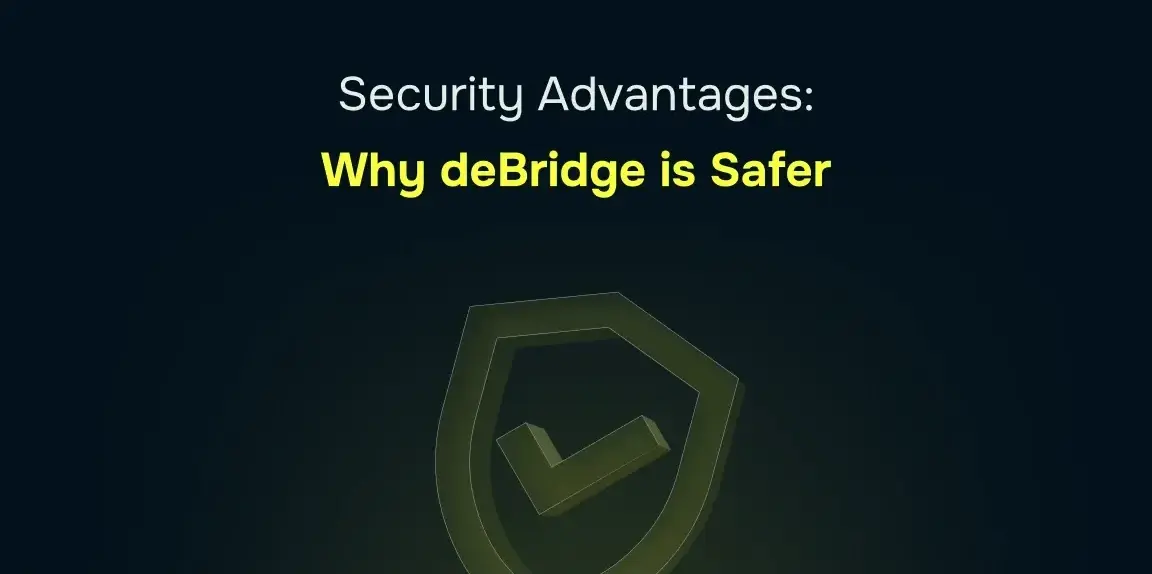
Security is at the core of deBridge’s design.
Every transfer minimizes risk without compromising on speed. Unlike traditional cross-chain bridges that pool user funds in liquidity pools, deBridge operates on a 0-TVL architecture, skipping the need for locked liquidity. This ensures assets are delivered natively, eliminating the risks of depegging or liquidity shortages.
deBridge has undergone 30+ audits and runs a $200K bug bounty program to incentivize white-hat security testing. With $10B+ in total volume settled since inception, deBridge has proven its reliability in real-world, high-volume conditions.
Today, many well-known crypto projects like Phantom, Solflare, Jupiter Exchange, Infinex, and more trust deBridge. It is built for users who like to stay one step ahead.
Conclusion
Bridging to BNB Chain doesn’t have to be slow, risky, or complicated. With deBridge, you get native asset transfers, such as BNB, in seconds.
Whether you’re a trader chasing high-yield opportunities, a power DeFi user, or a developer integrating cross-chain functionality, deBridge makes the process fast, safe, and seamless. Start instantly via the deBridge app or dive into our docs for integration guides.
